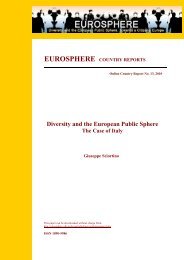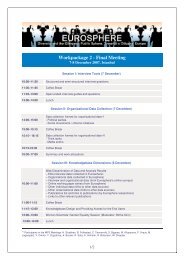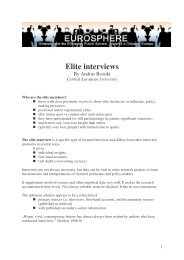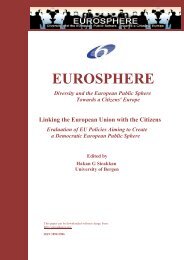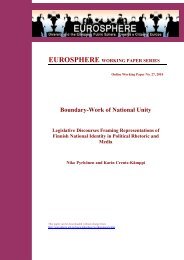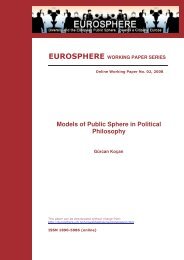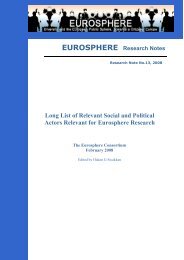Migrants, Minorities, Belongings and Citizenship. Glocalization and ...
Migrants, Minorities, Belongings and Citizenship. Glocalization and ...
Migrants, Minorities, Belongings and Citizenship. Glocalization and ...
Create successful ePaper yourself
Turn your PDF publications into a flip-book with our unique Google optimized e-Paper software.
Therefore, in contrast to analyses with continuous or interval variables, it is possible here<br />
to infer that the two explanatory models account for two different types of categorical<br />
variances in the dependent variables.<br />
On the other h<strong>and</strong>, further analyses – which are not presented here due to limited space<br />
– showed that the two participation patterns are strongly associated with the five<br />
belonging patterns. The belonging patterns account for 68% of the variation in<br />
“participation in all spaces” <strong>and</strong> 82% of the variation in participation in “essentialized<br />
versus glocal spaces”. This means that the five belonging patterns, which are orthogonal,<br />
explain much of the variation in the two participation patterns. At the same time, as we<br />
found in Tables 10 <strong>and</strong> 11, the two participation patterns are also associated with the two<br />
mental mobility patterns in different ways. Table 10 shows that one spatial mobility<br />
pattern (i.e. cross-country mobility) accounts perfectly for the variation in one of the<br />
mental mobility patterns (i.e. psychic mobility between group versus time references).<br />
Table 11 illustrates that the two participation variables are very important predictors of<br />
the general mental mobility.<br />
These considerations lead us to the following general conclusion: The Glocalmig<br />
measured the multidimensional belongings of the respondents. Separately, it also<br />
measured their mobility of mind between different references of identification. As the<br />
measurement of belongings represents the temporal <strong>and</strong> situation-dependent<br />
multidimensional belongings at the time of data collection, it is indicative of the nondynamic<br />
<strong>and</strong> temporally limited aspects of belongings. On the other h<strong>and</strong>, adding the<br />
mobility of mind dimension enriched the analysis <strong>and</strong> uncovered the dynamics of<br />
respondents’ multidimensional belongings. The belonging model shows the impact of the<br />
respondents’ belongings on the (mis)alignments they experience in different public<br />
spaces, whereas the mobility model shows the impact of the respondents’ ability to shift<br />
between different modes of belonging. This qualitative difference between the meanings<br />
of these two models is the source of the difference in the categorical variances they<br />
account for. Conclusively, we can arrive at the following clarifying model in Fig. 3.15, the<br />
specificities of which were delineated in the preceding chapters as well as in the nest<br />
section.<br />
98



